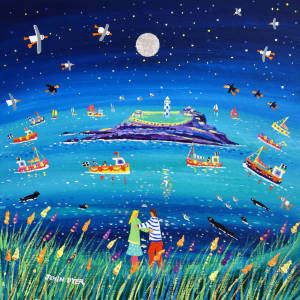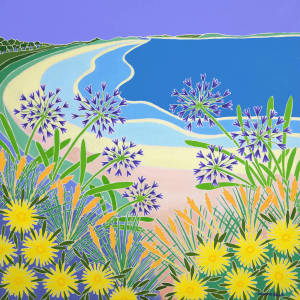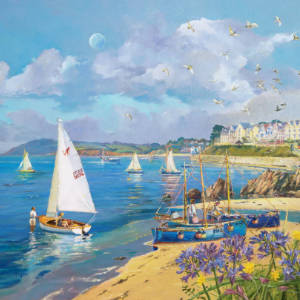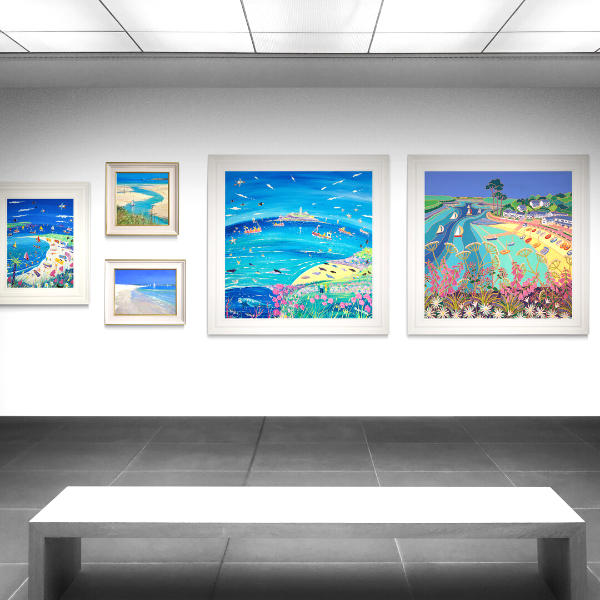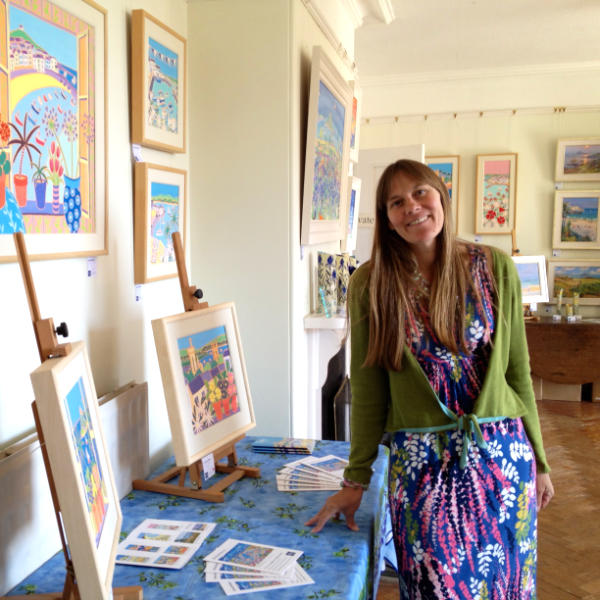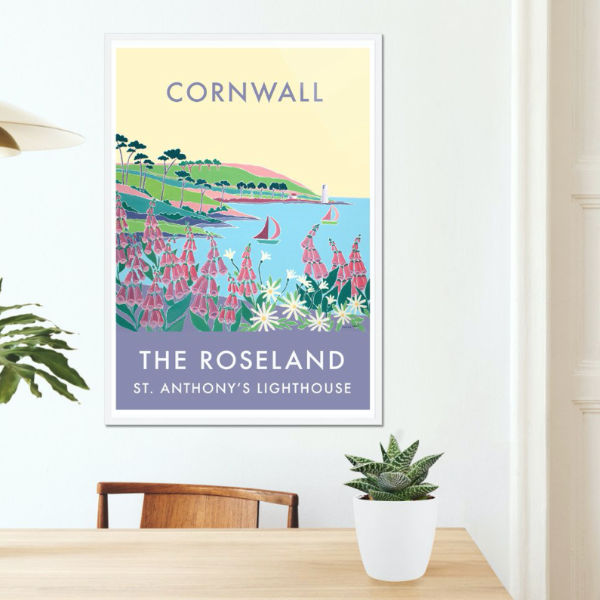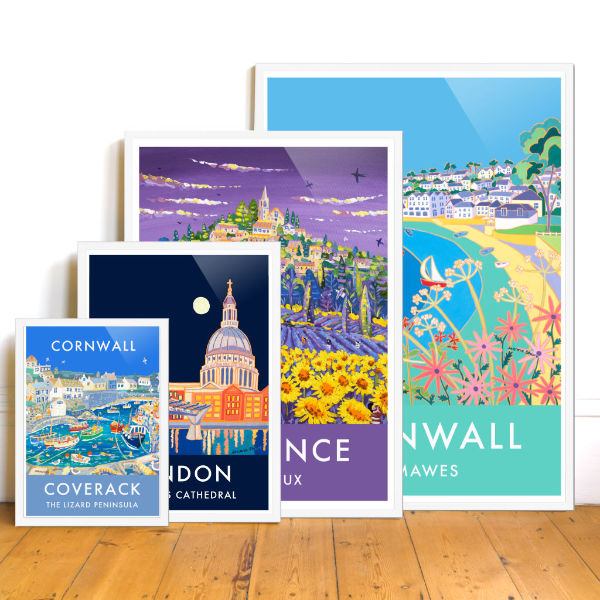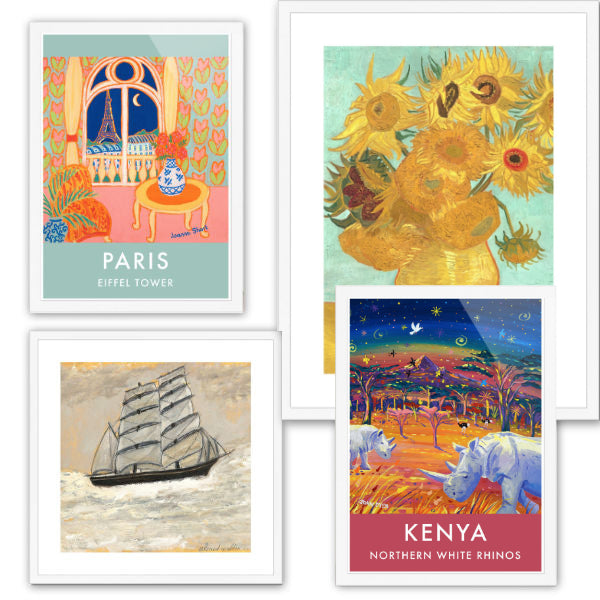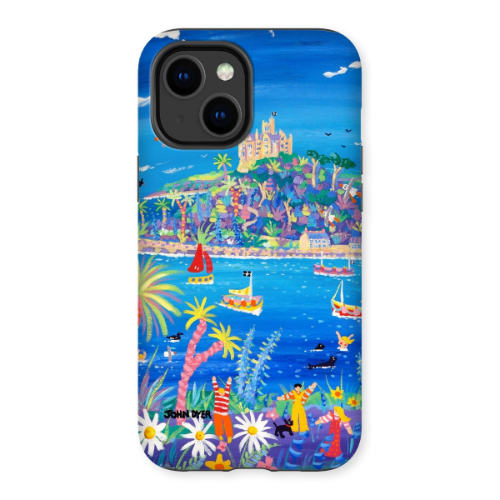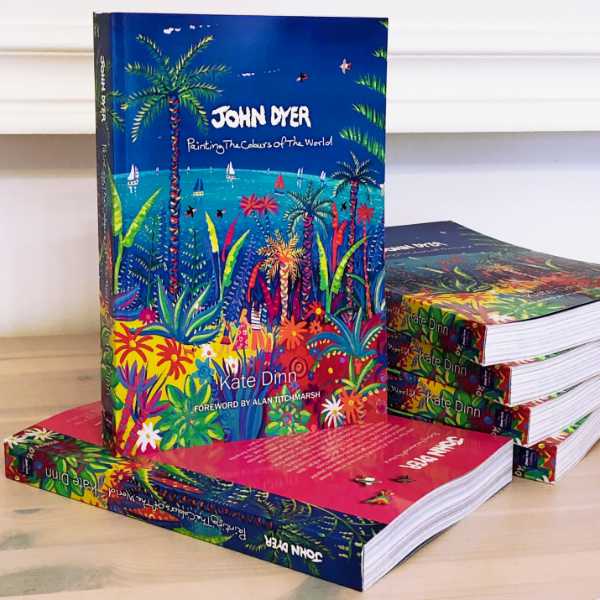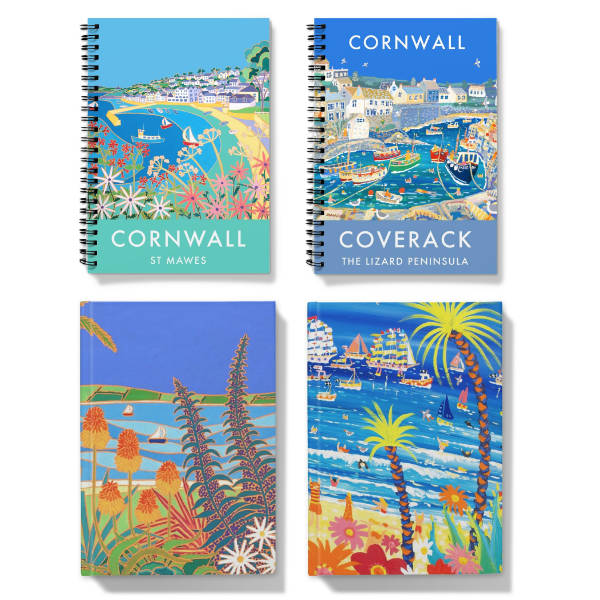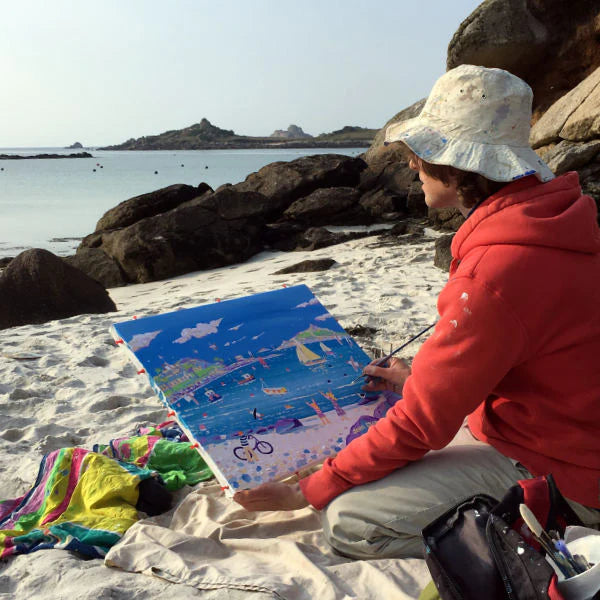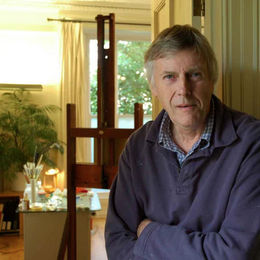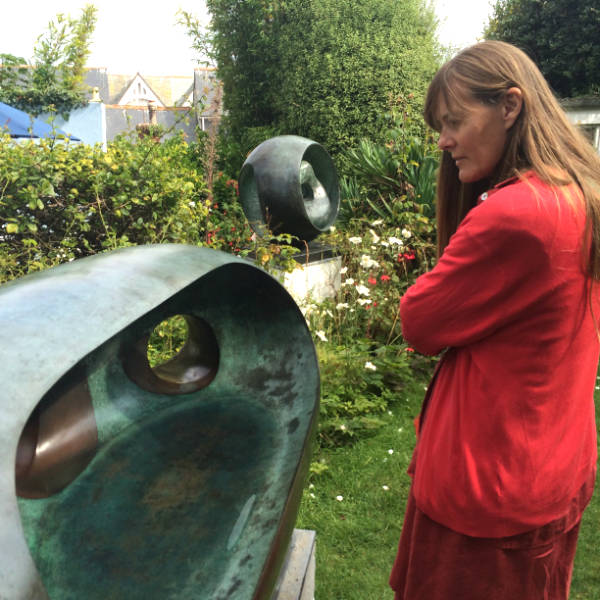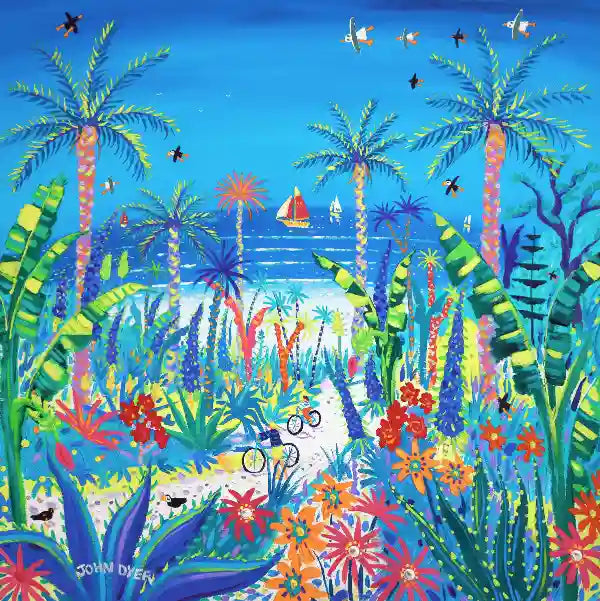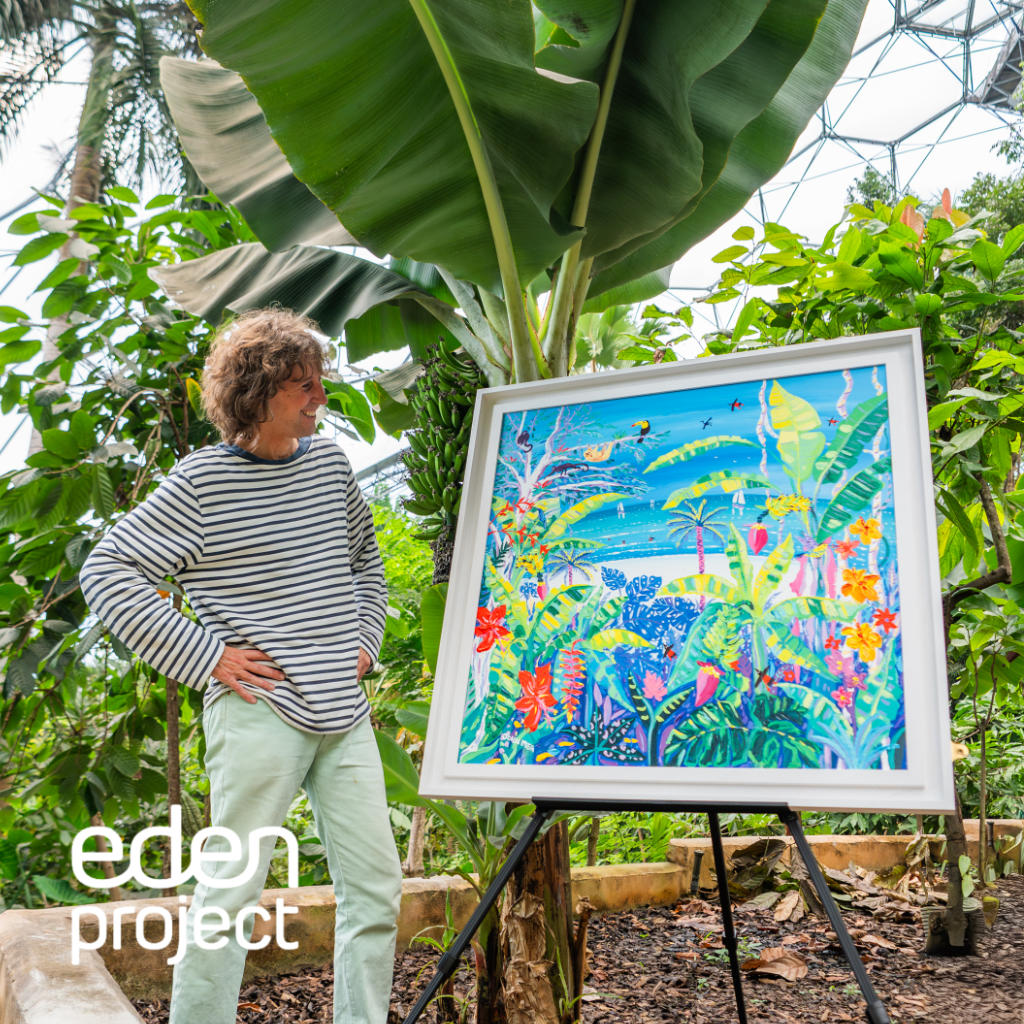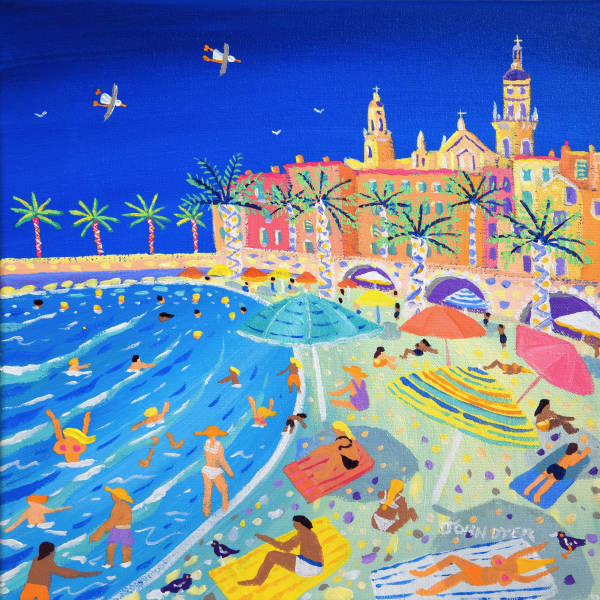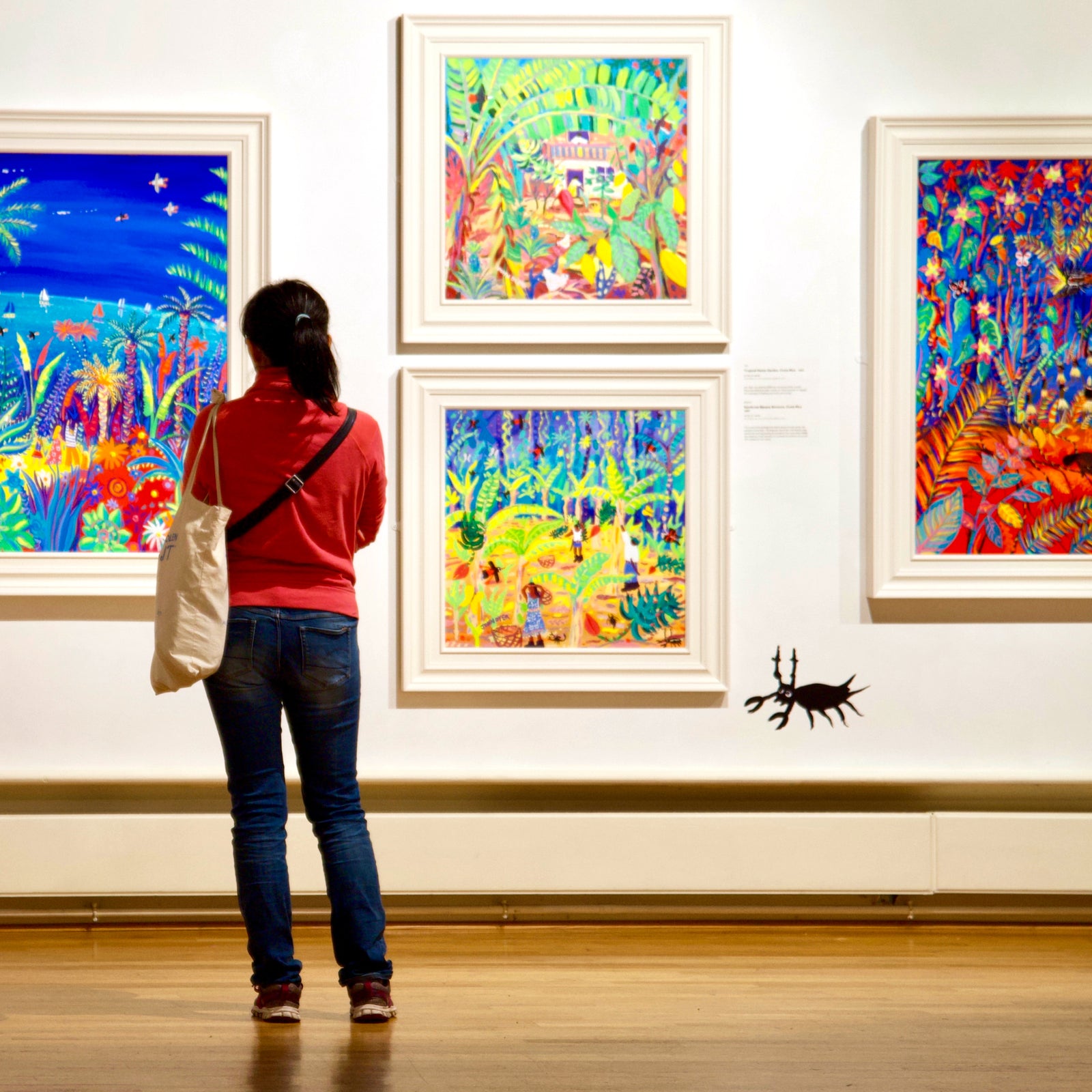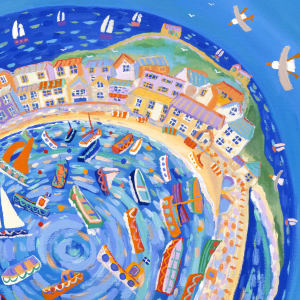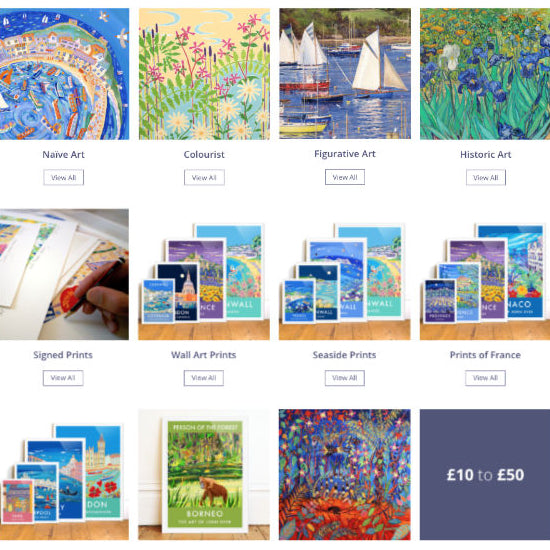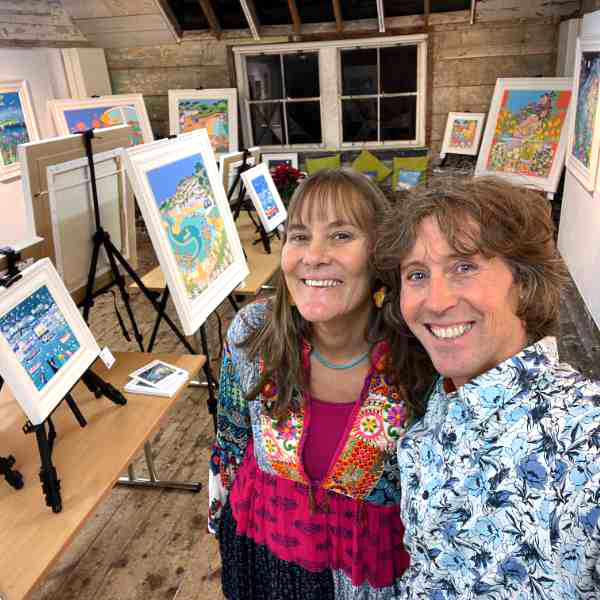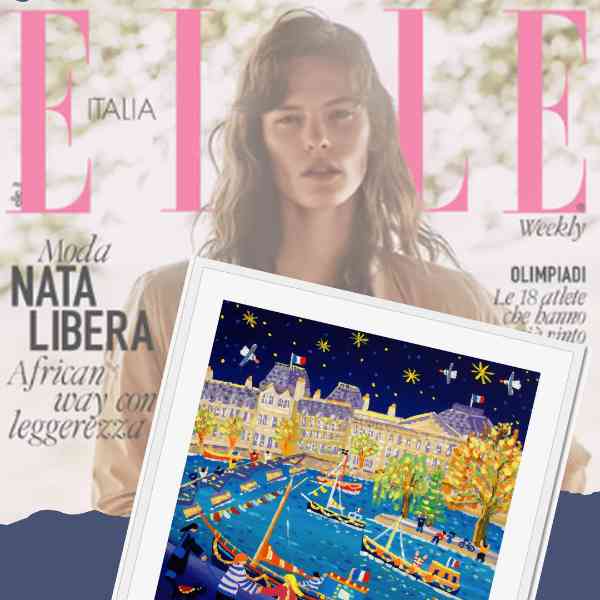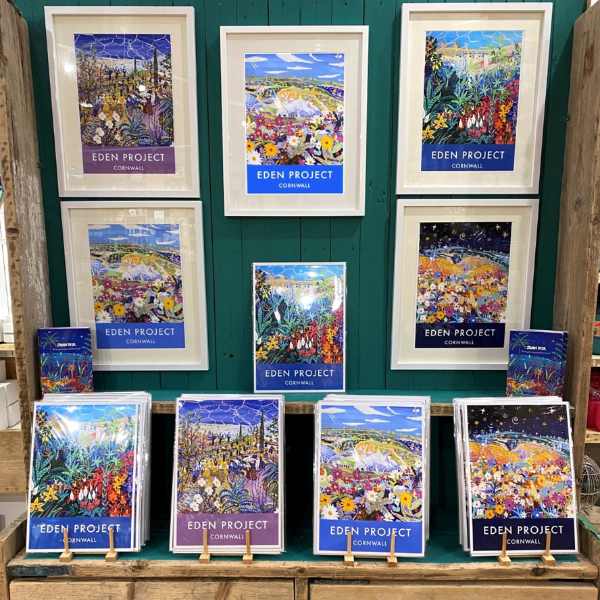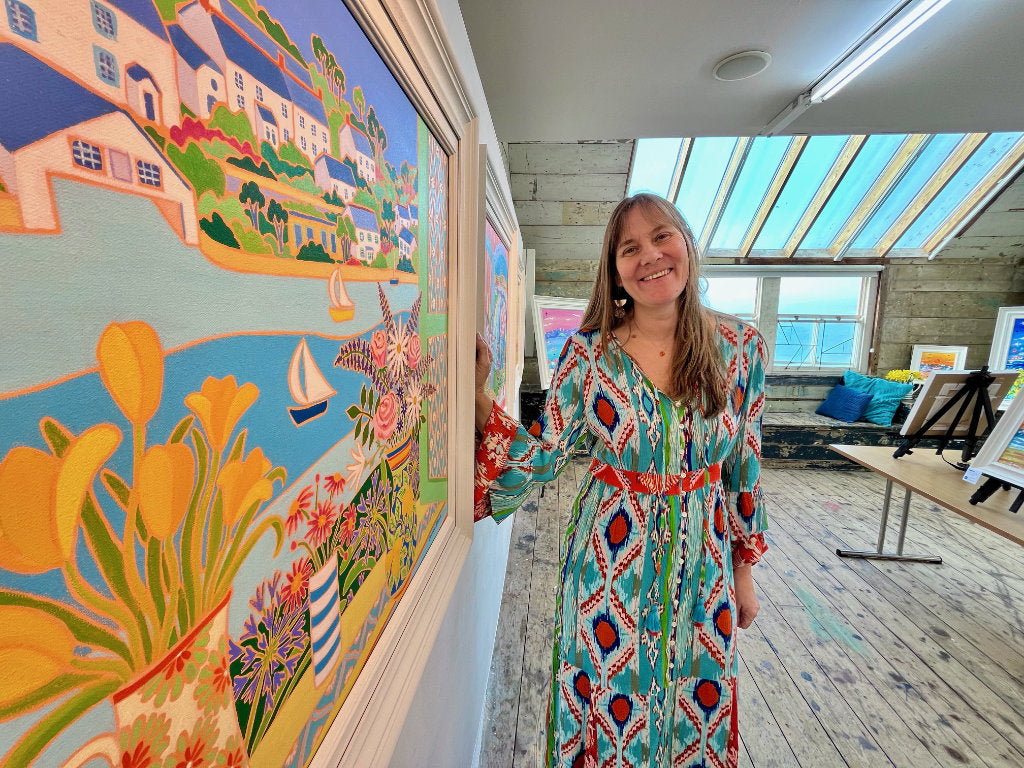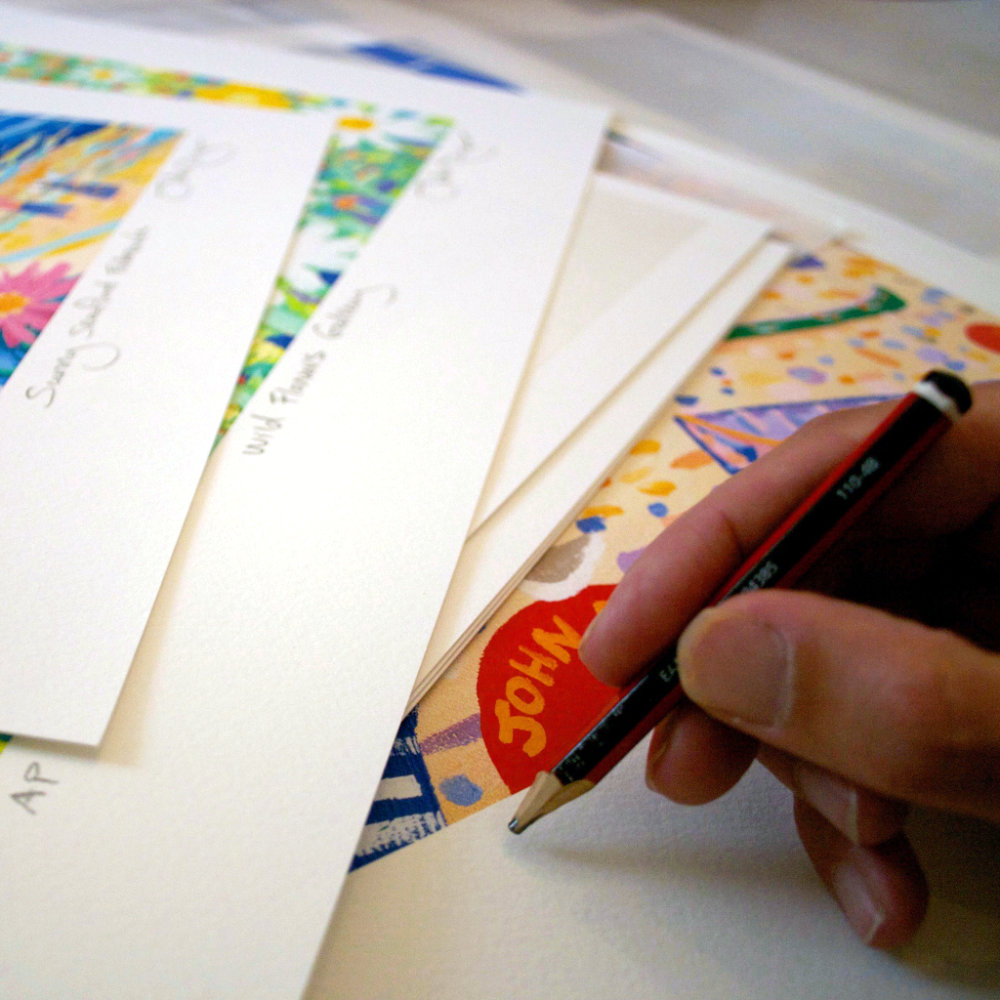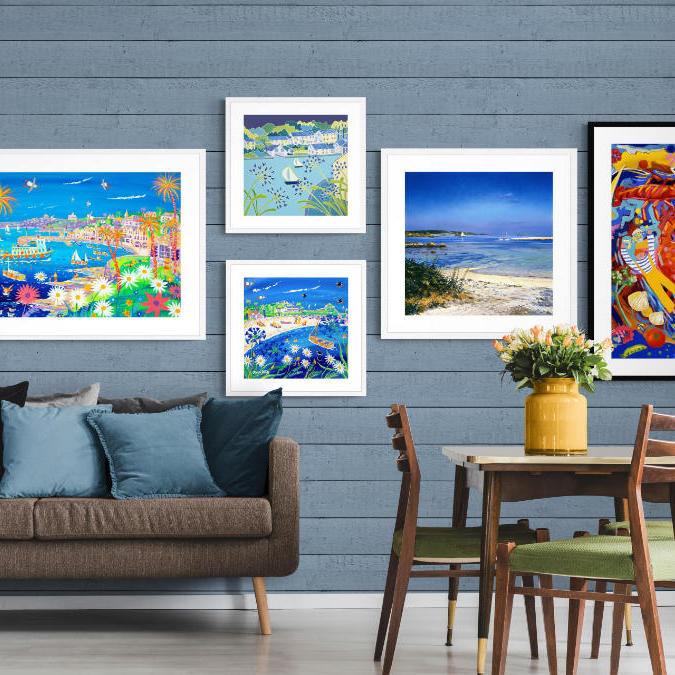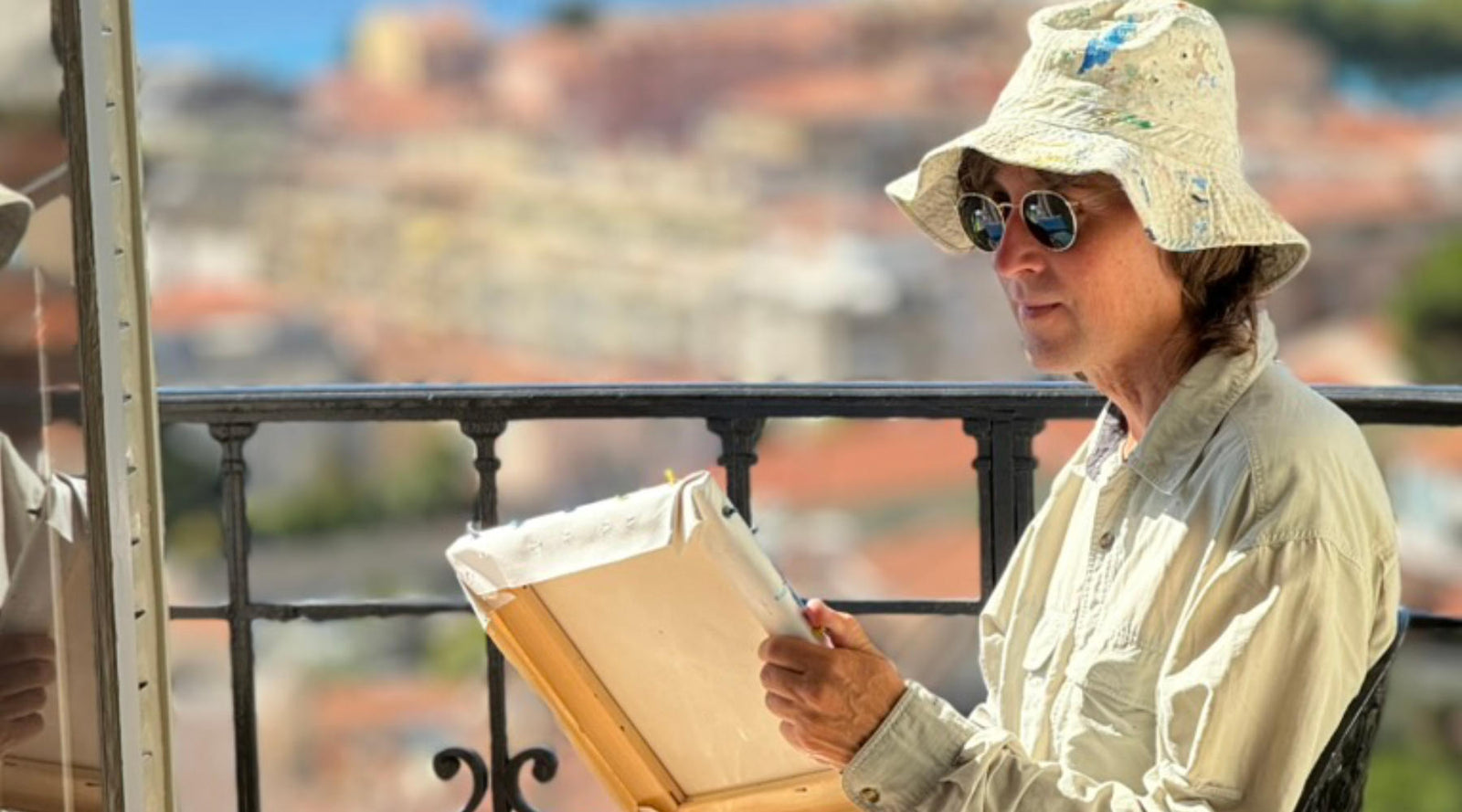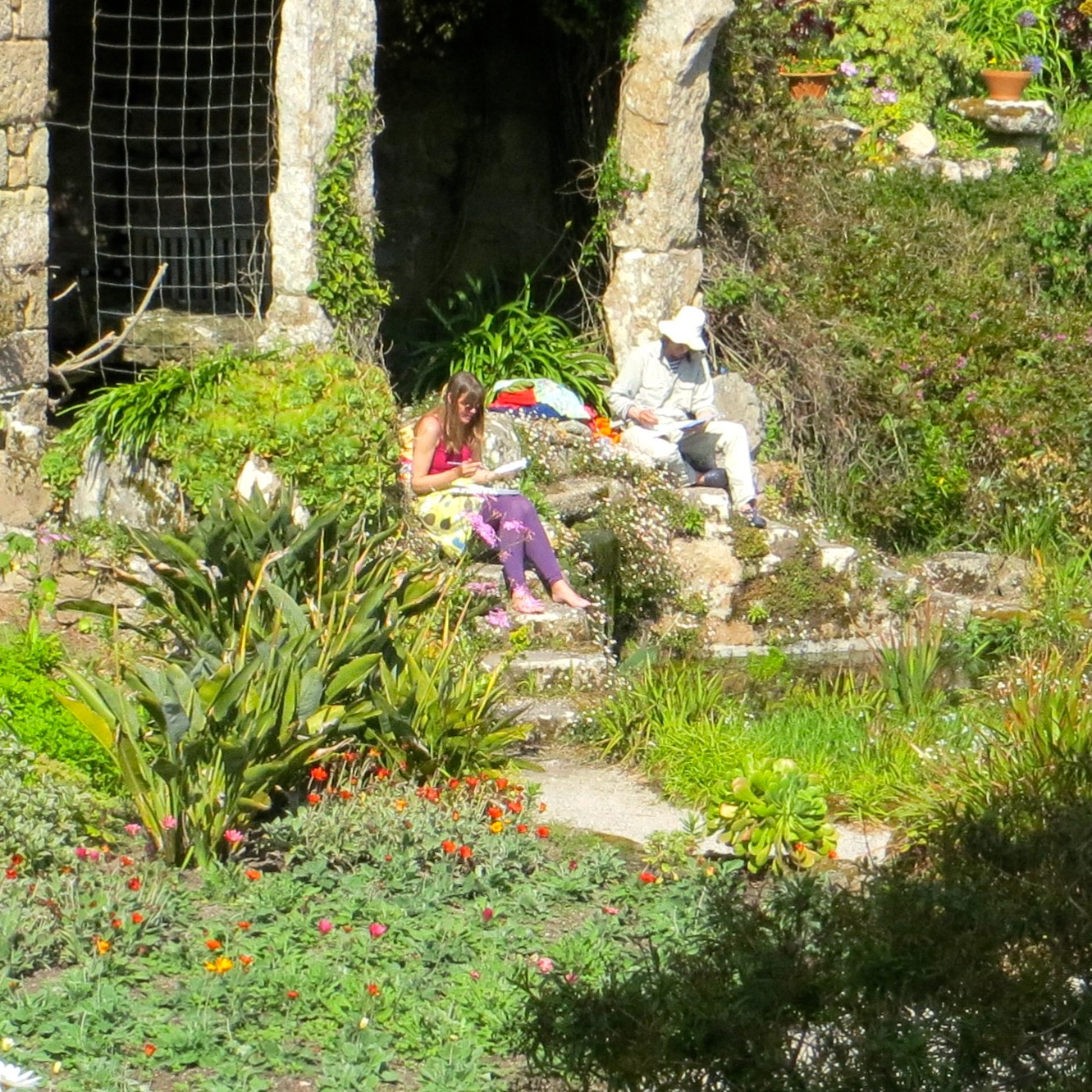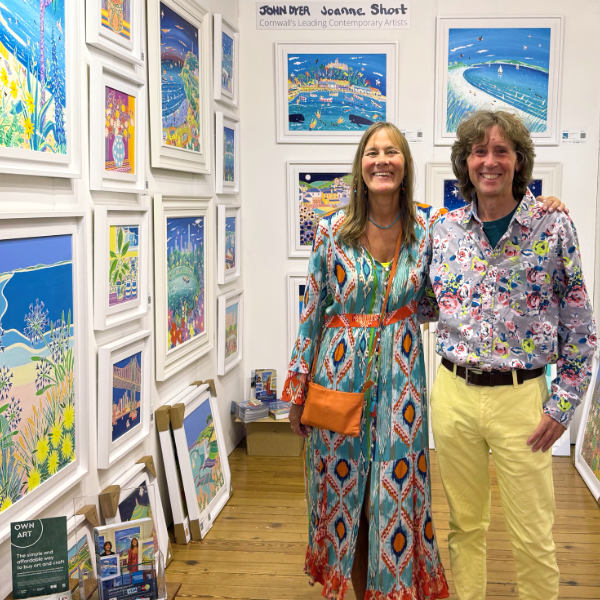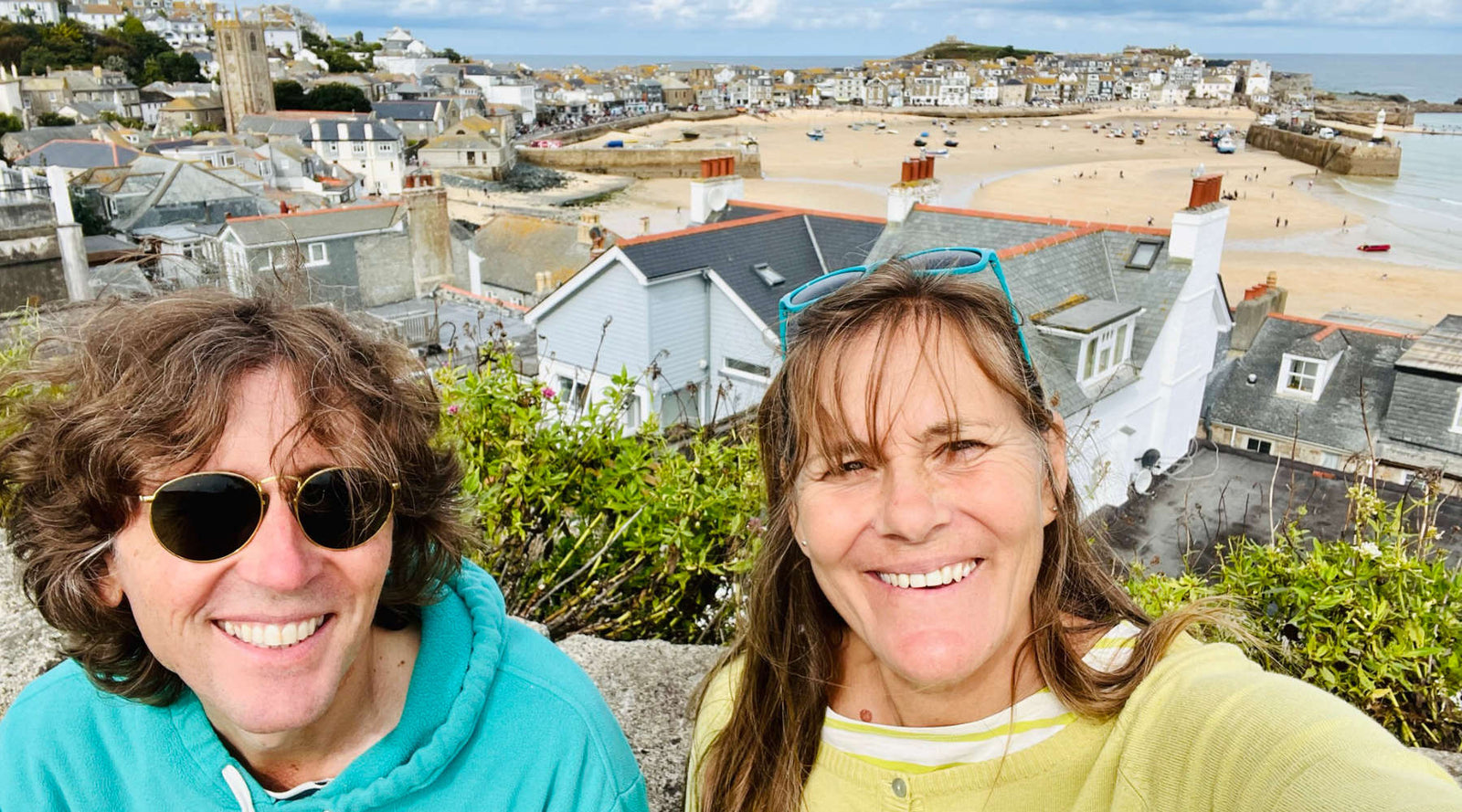
Above: Artists John Dyer and Joanne Short explore the coast path from Carbis bay to St Ives in Cornwall.
Following last week's blog "The Magical History of Painting in St Ives: The Artists Who Were Drawn to Its Soft Light and Turquoise Sea" John and I decided that we should explore the area ourselves and take in the beauty of all the things St Ives and the surrounding area have to offer. You can view all the paintings this walk inspired on our St Ives Exhibition page.
Above: John Dyer Painting. View to the Lighthouse, St Ives
If you're looking for a picturesque walk with plenty of art history thrown in, look no further than the route from Carbis Bay to St Ives. The winding path takes you past some stunning scenery and through the quaint town of St Ives, home to many famous artists over the years. We'll take a look at some of their work and explore the town that played such an important role in their development.
Knill Monument
We set off from the top of St Ives, leaving the town behind us, and walked up through the woods and onto the edge of the moors behind the town. There we found ourselves at Knill's monument, up on Worvas Hill. The view from the top is spectacular, stretching across the whole of Carbis Bay, with the sweeping beaches of Hayle towans and Gwithian, as far as Godrevy Lighthouse in the distance.

Above: Artist Joanne Short at Knill Monument, St Ives
This unusual 50ft granite obelisk, sometimes known as the Steeple monument, stands on Worras Hill in Carbis Bay and may be seen for miles around. It is situated on the edge of the Penwith moorland, very typical of the wild cornish landscape of West Cornwall. Originally intended to serve as a mausoleum for its eccentric creator, John Knill, former Mayor of St Ives, the building has never been used since Knill was actually interred in Holborn, London, where he died.
A somewhat odd legacy bequeathed to the St Ives community by Knill was that on St James' Day (25th July), every fifth year, ten young women dressed in white dance through the streets and up to the Monument. Here they would be joined by two widows and the mayor who danced with them around the monument, while spectators sang The 100th Psalm. And even today, with the 45th going off in 2021, the Knill Ceremony is held every five years!

Above: View from Worras Hill to Carbis Bay and beyond
Carbis Bay
As we dropped down into Carbis bay the sun began to sparkle on the sea below and the yellow sand glistened. it was a spectacular sight.

Above: 'To the Beach' sign, Carbis Bay
We followed the path down to the beach, passing under the impressive viaduct where the rail track runs alongside the coast. The Carbis Viaduct is located a short distance beyond the station, towards St Ives. Made of granite from a nearby quarry at Towednack it has three piers with four enormous 12m arches. It certainly felt enormous when standing beneath it!

Above: View of the viaduct, Carbis Bay
The new railway line built in 1877 by the Great Western Railway from St Erth to St Ives, required a viaduct to span the little valley that carried Carbis Water down to Baripper Cove. It is because of the construction of this railway that St Ives, originally a small fishing town, became frequented by tourists and became a popular spot for artists. This railway line offers some of the most spectacular views of the Cornish coast.

Above: Photo of the railway along the coast to St Ives
Carbis Bay became famous worldwide in 2021 with the G7 Summit being held there. The prime minister at the time, Boris Johnson said, “Carbis Bay is one of the most beautiful places in the world, as you can see, and it was a fitting setting for the first ever, net zero, G7 Summit. I would like to thank all the wonderful people of Cornwall for their hospitality.”

Above: G7 summit, Carbis Bay
Porthminster Beach
The coastal path winds its way along the coast until it starts to drop down to the next beach, Porthminster beach. The abundant plants and flowers in the gardens near the beach were an incredible sight. Even the edge of the beach was lined with palm trees.

Above: Porthminster beach with palms
The coast of Cornwall is home to many subtropical plants and flowers which thrive in the mild climate and provide a stunning backdrop to any walk. These flowers are a huge inspiration to me and appear in many of my paintings of the Cornish coast.
Above: Signed Limited Edition Print by Cornish Artist Joanne Short. 'Boats in the Bay, St Ives'
At this point in our walk we were just starting to get tantalising glimpses of St Ives harbour. We followed the path along the back of Porthminster Beach and started climbing back up towards the top road so that we could get a good view of the town and harbour from above. The view is truly spectacular..
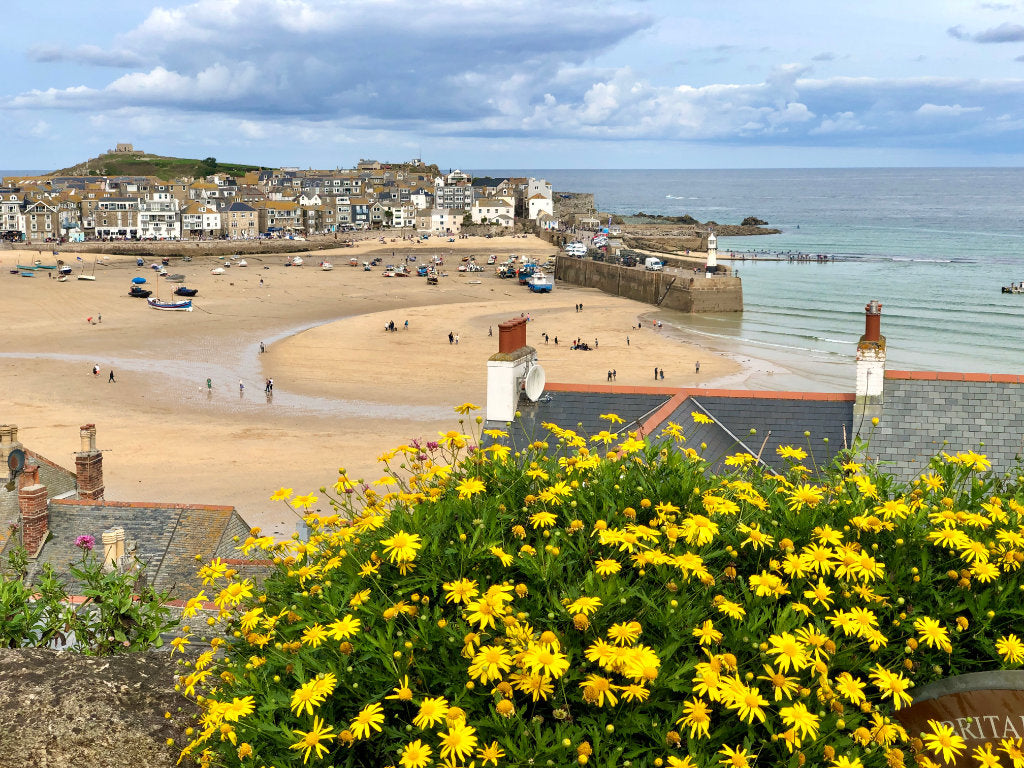
Above: View of St Ives harbour from above
The Cornish light is magical here in St Ives. It dances across the harbour and catches the colours of the fishing boats and glistens on the sea beyond the harbour wall, giving the illusion of a never-ending horizon. Looking across the rooftops of the cottages to the harbour, I am struck by how picturesque this coastal town is.
Above: Limited Edition Print by Cornish Artist John Dyer. 'Stunning View, St Ives'
The church is an iconic landmark, and the fishing boats add a splash of colour to the scene. At low tide, the sand is revealed and the sea looks like a sheet of glass. It's no wonder that this town is so popular with artists, and has been for many years.

Above: John Dyer above St Ives town and harbour
The picturesque town of St Ives has been an inspiration for artists throughout the ages, with even well-known British painter Turner and American artist Whistler having worked here. In 1883/84, another notable artist, Sickert also took up residence in Barnoon Terrace.
St Ives Art Club
We made our way down to the harbour where we discovered a distinctive half-timbered building set on the seawall of Westcott’s Quay.

Above: St Ives Art Club
In a one-of-a-kind setting with a panoramic view of the harbour and sea, the St Ives Art Club was established by members of the St Ives artists colony in 1890. Downstairs features a gallery space, and upstairs there is a theatre hosting events for both members and guests alike. Entertainment, as well as drawing classes with models, was historically a feature on Saturday nights.
Well-known names in the world of painting, potting, sculpture and writing who had links to the St Ives Arts Club, include George Bradshaw, Alfred Hartley, Jack Titcomb and George Turland Goosey.
The downstairs gallery can still be rented and there are regular shows of contemporary modern art by local artists.

Above: Boats in St Ives Harbour
We then walked across the harbour as it was low tide, and enjoyed looking closely at the multicoloured boats so typical of St Ives and so fun to paint.
Above: Signed Limited Edition Print by Cornish Artist John Dyer. 'Boats and Ropes St Ives'
What is the 'St Ives School'?
The 'St Ives School' is a term that refers to a group of artists working in this Cornish town after World War 1 who set up an artists colony. Artists in Cornwall have played an important part in the history of British art.
Due to the pleasant climate and Cornwall's extraordinary light, British artists who had been painting on the continent en plein air came back to St Ives to find and paint new landscape and seascape subjects.
Ben Nicholson and Christopher Wood visited St Ives in 1928 and discovered the naïve art of local artist Alfred Wallis. This chance meeting inspired the modern and progressive St Ives art movement and the colony of artists at St Ives and the wider art community in Cornwall which is a triangle of creativity from St Ives to Newlyn to Falmouth.
Above: Alfred Wallis Open Edition Cornish Art Print. 'Headland with Two Three-Masters'. St Ives Cornwall
After the second world war, Barbara Hepworth and Ben Nicholson inspired a new and younger generation of artists in St Ives. By the 1950's St Ives had become the centre for British and European modernism art and was in fact the global hub for contemporary art, quite an achievement for a remote fishing town in Cornwall.
The new generation of younger artists were later referred to as 'the middle years artists' and they included Roger Hilton, Peter Lanyon, John Wells, Wilhelmina Barns-Graham, Bryan Wynter, Patrick Heron, Terry Frost, Paul Feiler, Modern potter and Bernard Leach (who's famous pottery studio on the very edge and outskirts of St Ives 'The Leach Pottery' is still a functioning pottery and studio).
It is with this group of 'middle years artists', alongside Barbara Hepworth and Ben Nicholson, that the term 'St Ives School' became associated and is still associated to this day.
St Ives Society
Across the harbour on the other side of the town is the building housing the St Ives Society. This tall building, the Mariners Church, stands proud above the small fishermens' cottages surrounding it.
In 1927, Commander George Fagan Bradshaw proposed the creation of a society to improve artistic standards in the colony and to showcase works that were highly regarded in artistic circles.

Above: Mariners Church stands tall in the St Ives townscape and still houses the St Ives Society of Artists
The Mariners Church in Norway Square is still, to this day, the home of the St Ives Society of Artists. It serves as a magnificent contrast to the jumble of irregular higgeldy piggeldy cottages and houses around it. It can be seen from almost every vantage point in the town. Not only does it play an important role in the visual look of St Ives, but also plays a significant role in the history of the artists' colony.
The Crypt
This venue is located under Mariners Church where the St Ives Society is located. The 'Crypt Group' was a subset of the St Ives Society of Artists that broke off because they embraced a more modern abstract art style, as opposed to the traditional approach favoured by most members.
In 1947, these modern artists began to organize their own shows, most notably in the church's crypt. Because of this venue they were dubbed the 'Crypt Group'. There were two exhibitions in 1947 and a third in 1948. The members of this group became founding members of the Penwith Society of Artists in 1948/9.
Above: The Crypt Art Gallery
The Crypt, is still available to rent out for exhibitions by local St Ives artists. It is a large airy space with room to exhibit a substantial number of large paintings. The John Dyer Gallery held a major exhibition in the Crypt Gallery in May 2023.
Penwith Society of Artists and Gallery
Founded in 1949 by artists including Ben Nicholson, Barbara Hepworth, Sven Berlin, Wilhelmina Barns-Graham, Bernard Leach, Peter Lanyon and other artists in this group, Penwith Society of artists and Gallery are located in an old pilchard packing factory where they moved to in 1961.
Above: Penwith Society and gallery
Now a combination of galleries, artists' studios and print workshop with a shop and cafe the Penwith Society of Artists still offers exhibitions of contemporary art by members and associates from Cornwall and countrywide.
St Ives School of Painting - Porthmeor studios
The St Ives School of Painting was founded in 1938 by Borlase Smart and Leonard Fuller. Based at the Porthmeor studios in the heart of St Ives' artists' quarter.

Above: Painting of St Ives School of Painting by St Ives artist Bryan Pearce (1929-2007)
At that time, Smart was living in the town and persuaded Fuller to come from London to join him; together, they established the school close by Wallis’s house in Back Road West using Denis Mitchell’s former studio. The new business venture was an immediate success.
Over the years many of the young modern 'middle years' St Ives artists regularly used the facilities of the School, particularly the life classes.
The School flourished throughout this period attracting both local and visiting students.

Above: Porthmeor Art Studios
By the late 1980s, a team of artists and tutors, who were very popular with students wishing to learn about contemporary ideas, had been assembled. By 1990, visiting school groups from all over the country regularly came to attend workshops at the School.
Today the studios host a wide variety of artists and courses inspired by St Ives and the historic setting of the studios. They are very much still part of the creative energy and heart of St Ives culture with artists exploring the wild landscape of Cornwall through painting which the St Ives School of Painting has always had at its core. In 2023 John Dyer was invited to be one of the St Ives School of Painting tutors for children and teenagers.
Alfred Wallis (1855-1942)
It was exciting to find ourselves standing outside the cottage where artist and mariner Alfred Wallis once lived. Such a humble cottage for such a now well-known figure.

Above: Joanne Short outside Alfred Wallis's cottage, St Ives
Wallis was a Cornish fisherman and artist known for his naîve art. He began painting at the age of 70 without having any formal training, using household paint on pieces of cardboard. He painted rustic harbour views and shipping scenes painted in an unsophisticated style. Although he achieved little commercial success, his work was admired and championed by progressive artists such as Ben Nicholson and Christopher Wood.
Above: Alfred Wallis Open Edition Cornish Art Print. 'Against Longships, Fog'. St Ives Cornwall
Tate St Ives
Overlooking the spectacular Porthmeor Beach, with far-reaching views across the Atlantic, the Tate Gallery was built in 1993 to house and exhibit work by modern British artists with links to the St Ives area. There are works in their permanent Tate Collection by many St Ives School artists such asPatrick Heron, Peter Lanyon, Bernard Leach, Bryan Pearce, Alfred Wallis, Bryan Wynter, Peter Lanyon, Roger Hilton, Terry Frost, William Scott, and Wilhemina Barns-Graham.

Above: Tate Gallery, St Ives
Barbara Hepworth Gallery
Just a short walk from Porthmeor Beach and The Tate St Ives is the Barbara Hepworth Gallery.
Hepworth moved to St Ives in 1949, where she set up Trewyn studio and sculpture garden. The museum and garden, which contain over 30 of her works in wood, stone, plaster and bronze, offer visitors a rare opportunity to see the work of one of Britain’s most important 20th century artists.
Above: Barbara Hepworth Gallery
The living room is still furnished exactly as she left it, and her workshop contains all of her tools, equipment, materials, and unfinished pieces. Her family opened the museum according to her wishes in 1976, and it houses the largest collection of permanently-displayed Barbara Hepworth sculptures anywhere. It's lovely to wander among the sculptures in the peaceful garden setting.

Above: Barbara Hepworth Sculpture Garden and Studio
Because she played such an important part in the artistic history of St Ives, not only is there a Barbara Hepworth museum dedicated to her work alone but her sculptures are also located around the town.

Above: John Dyer with Barbara Hepworth sculpture in St Ives
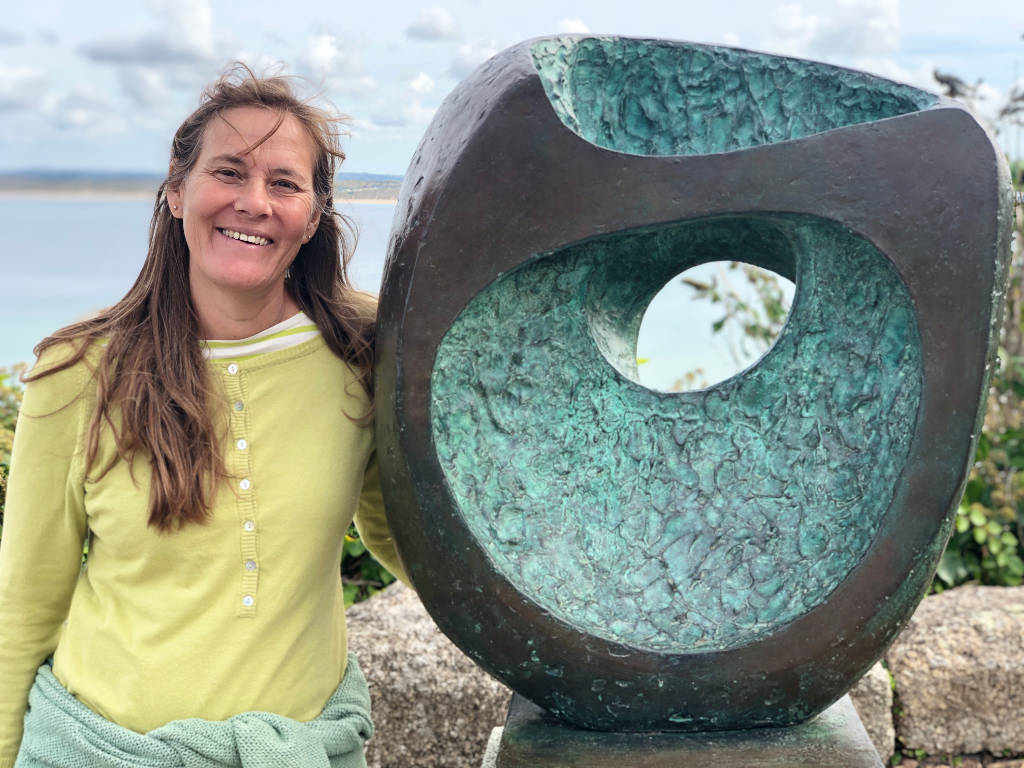
Above: Joanne Short with Barbara Hepworth sculpture, St Ives
Conclusion
We had a fantastic walk, taking in the beautiful cornish coastline and enjoying the impressive views across Carbis Bay to Godrevy Lighthouse.
Visiting the various art galleries and artist residences in St Ives provided a wonderful opportunity to learn more about the history of art in this vibrant community. The interesting buildings and stunning scenery made for a very pleasant walk, and it was fascinating to see how the landscape has influenced the work of local artists.

Above: A glimpse of John Dyer's new painting of St Ives as the artist applies the finishing touches
Now it is our turn to put together a collection of work inspired by this stunning scenery and deep-seated artistic history.
View and buy art inspired by St Ives on The John Dyer Gallery.

